
University of Kentucky Department of Entomology







Get This Bug Off of Me!by Stephanie Bailey
|
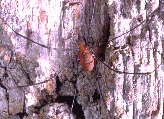 UK Dept. of Entomology | Daddy-long-legs look like long-legged spiders but are actually relatives of spiders. They only have one body section (spiders have two body sections). They do not sting or have venom. Daddy-long-legs feed on plants and sometimes decaying materials in forests. |
Millipedes cannot hurt people. They do look similar to centipedes (their sometimes dangerous relatives), but with two big differences:
- millipedes have chewing mouthparts
- millipedes have two pairs of legs for each body segment (centipedes have only one pair of legs per segment).
Millipedes are scavengers, feeding on either living or decaying plant parts near the forest floor. Many species are able to give off a foul smelling fluid that is toxic to insects, but won't do any damage to humans.
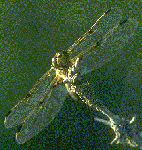 copyright Corel PhotoCD | Dragonflies are some of the largest insects. They are beneficial insects--predators of smaller insects such as mosquitoes and crop pests. Dragonflies knew about fast food long before humans: they hold their prey in their legs and munch while flying--sort of like picking up an order of "mosquito in a basket" to go! |
Despite old folktales that claim they sew up your ears or your lips, they do not attack humans. If you happen to catch one (good luck!) and are holding onto it, it might pinch, but it can't break the skin.
The immature stage of this insect lives underwater in streams and lakes and feed on aquatic insects and other arthropods. Immatures of some of the larger species even feed on small fish. The aquatic stage can't hurt humans either.
| Mayflies look similar to dragonflies, except their hind wings are smaller than the front wings, and they have two or three "tails," called styli. They are usually seen near water. These insects do not feed at all as adults. They don't have any functional mouthparts. They will not harm humans or any other living creature. | 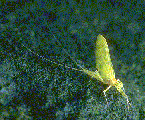 |
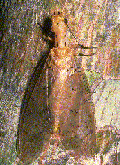 | Dobsonflies are not very common, but are very distinctive. They are very large and the males especially have very large fanglike mouthparts. However, as an adult, these mouthparts are not used in aggression or defense, but only in trying to woo the females. They are actually quite docile. The immature stage of this insect, known as a helgrammite, lives under rocks near water. It is a little more menacing in that it will give a good pinch if you pick one up, but it is not dangerous. |
| May beetles, June beetles and Japanese beetles belong to a very closely related group of beetles called scarabs. People in Egypt thought scarabs were good luck. Beetles may fly into and land on people. They can't hurt humans, although if you catch them and won't let them get away, they may give a slight pinch. | 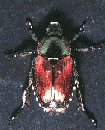 D. Potter 1998 |
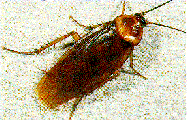 University of Florida-Entomology | Cockroaches have been hated and feared for centuries. While historically they have been associated with poor housing and dirty conditions, they can be found in any type of structure, regardless of income level. However, they do not have any biting or stinging ability. |
Because cockroaches can be found in filthy areas as well as clean areas, they pose a threat to human health by carrying disease-causing bacteria onto surfaces or into food in the home when they move from one place to another. People may also develop increasingly severe allergies to cockroaches themselves with continued exposure.
| Praying mantids are predators of several crop and garden pests. Although they look quite menacing, they do not have the ability to hurt humans. They may make good pets, in fact, as long as they are well fed with smaller, soft-bodied insects, and water is available. Otherwise, they are best left in a garden, working at keeping pests away. |
| Lacewings are interesting-looking insects which, as larvae, are considered beneficial because they are predators of pest insects. Lacewing eggs are laid at the end of very slender stalks, which makes them very easy to distinguish. They will not hurt humans. |
| Walking sticks are well named. That's exactly what they look like! They are plant feeders, and have no ability to hurt humans. They make great pets. Be sure to provide them with plenty of plant material that they will eat. | 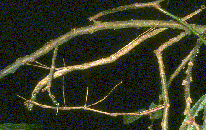 copyright Corel PhotoCD |
| Grasshoppers are grass feeders that normally want nothing to do with humans. When handled, they may regurgitate a brown liquid as a scare tactic, and may pinch with their mandibles (jaws), but their jaws are not strong enough to do any damage. Other than that, they do not pose a threat. |
| Although silverfish are household pests, making their living in cracks and crevices that are warm and moist, and feeding on starchy substances, they have no directly harmful effects against humans. |  |
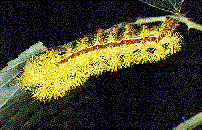 | Many caterpillars found feeding on leaves are not harmful, and may be handled and even raised. However, any caterpillars with hairs or spines should be left alone or handled with extreme care (wear gloves!). Often, caterpillar spines are very sharp, and they sometimes contain a chemical irritant. |
A few exceptions are woolly worms (woolly bear caterpillars) and the hickory horned devil, a caterpillar with very large projections, that is not harmful at all. In general, though, it's better to be safe than sorry. For more information see Entfact 003: Stinging Caterpillars.
| Butterflies and moths are very beautiful and graceful creatures. When caught, they will probably put up a fight by fluttering their wings, which can be unnerving but isn't harmful. If a butterfly lands on a person, it is possible that it just wants a sip of sweat, which contains salts that butterflies need. Their mouthparts are only modified to suck nectar and other liquids, and they will not bite or sting. | 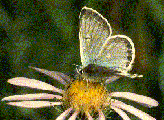 copyright Corel PhotoCD |
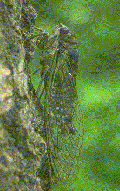 copyright Corel PhotoCD | Cicadas are large, distinctive creatures that are common in late summer and make very loud, unnerving noises, especially when disturbed. They do not feed as adults, and other than making noise, will not bother people. |
Dangerous Insects and Relatives
Even insects that do have the ability to bite or sting will usually do so only when mishandled or otherwise mistreated.
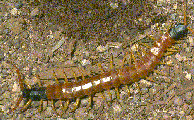 | Centipedes are not actually insects but are closely related to insects. They have long flattened bodies, with at least 15 pairs of legs, and fangs, which can inflict a painful bite. |
Centipedes can be distinguished from the similar but harmless millipedes by having fangs (instead of chewing mouthparts), and one pair of legs per body segment (versus two pairs of legs per body segment in millipedes).
| Ticks are also insect relatives. They can be found in wooded areas, or fields with tall grass. Ticks are very small, and many are hard to see. Once female ticks bite, they swell up with the blood of the host. When entering an area that may be infested with ticks, the best way to keep from getting bitten is to tuck pantlegs into socks, and to wear loose-fitting clothing. | 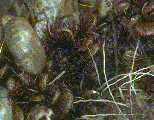 UK Dept. of Entomology |
Ticks are dangerous because of the diseases (Lyme disease, Rocky Mountain spotted fever, etc.) they may carry. Ticks often do not attach immediately, but walk around over the skin until they come to a tight place, such as around the waist or wherever clothing is tight on the body. Check yourself or have someone else check you for ticks as often as you can, so you can remove them before they bite. If a tick does attach to the skin, do not try to pull it off with your fingers, because the mouthparts may break off underneath the skin. It is better to use a clean pair of tweezers, grasping the tick as close to the front of the head as possible, to pull the tick off with its mouthparts intact. For more information see Entfact 618, Ticks and Disease.
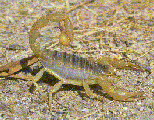 copyright Corel PhotoCD | Scorpions are very distinctive animals. The tip of the abdomen has a sting, and the first pair of legs are pinchers. It is best to leave these creatures alone. Kentucky does have a native species of scorpion , in scattered populations throughout the state, but they are less than an inch long at maturity. Their stings are not deadly, but can be as painful as a bee or wasp sting. |
| Lice are highly modified insects. They have no wings, and their legs are modified to move through animal or human hair. The best way to protect yourself from lice is healthy hygiene and not sharing brushes, combs, hats, etc. | 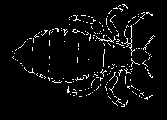 |
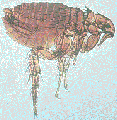 UK Dept. of Entomology | Fleas are pests of dogs, cats, and livestock. They have legs which can jump relatively long distances, for changing hosts, and comblike appendages that will help the insects resist being brushed out of hair. The immatures or larvae are very tiny wormlike creatures, and can be present on fabric, carpet, or outdoors. |
Both adults and larvae are present outdoors, where pets have been, in warm weather. Fleas generally do not prefer humans, however they may try to feed on humans if they have been starved for a long period of time. Fleas have also been known to carry diseases such as black plague (from fleas that usually infest rats), although there is not a lot of risk of those diseases in the United States at this time. See Entfact 602, Ridding your Home of Fleas and Entfact 628, Pet-Centered Flea Prevention and Control, for more information.
 copyright Corel PhotoCD | Honey bees are a part of a colony or community. There is a queen bee which lays eggs, drones (males), and workers which are all females. The workers are responsible for maintaining the hive as well as finding nectar and pollen to feed the colony. |
Bees will not generally attack people. However, when people get too close to the hive, or swat at the workers, workers may sting in defense.
If bees are flying nearby, the best strategy is to stand still or run away. Swatting may only make bees mad. If a bee does sting, sometimes people have allergic reactions, including rapid tissue swelling and difficulty breathing. If this happens, seek medical attention immediately. This could be a life-threatening situation if the person is highly allergic to bee venom.
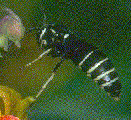 UK Dept. of Entomology | Solitary bees and wasps also have to find food for their offspring. If you leave them alone, they will probably leave you alone, although some wasps may be more aggressive in the fall when fewer food sources are available. Be aware that honey bees can only sting once, but wasps are able to sting repeatedly. |
Stag beetles are related to scarabs. However, they are a little more aggressive. The males have very large mouthparts called mandibles that can inflict a very painful pinch if they are mishandled.
| Blister beetles can also be harmful, especially to livestock. Their blood contains a substance called cantharadin which will cause blisters if it comes in contact with skin or is swallowed. | 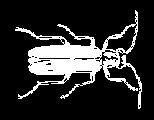 |
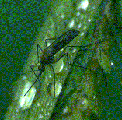 copyright Corel PhotoCD | Mosquitoes are very well-known human pests. Only the females bite; they need blood to reproduce. What actually itches when mosquitoes bite is the saliva that is injected while the mosquito inserts her mouthparts under the skin. |
Mosquitoes are found most frequently near water, although they can travel a fair distance looking for hosts. Besides lakes and streams, mosquitoes breed in any pool of water, such as birdfeeders, puddles and old tires.
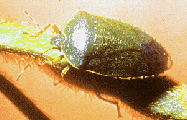 UK Dept. of Entomology | Most 'true bugs,' a group of insects including stinkbugsand boxelder bugs, are harmless. |
| However, assassin bugs such as the wheel bug, ambush bugs and giant water bugs can inflict a very painful (although non-poisonous) bite. | 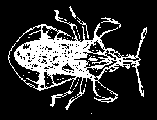 |
Helgrammites are another name for immature dobsonflies. These larvae live in streams. In contrast to the adults, the immature's large mouthparts are quite functional, and can inflict a painful bite. Use forceps or a twig to move them rather than touching them if possible. If you must handle them, be careful!
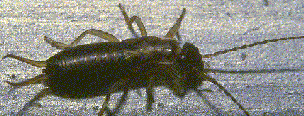 UK Dept. of Entomology | Earwigs can be found in warm, damp basements and garages. |
They have two tail-like appendages which look very much like tweezers. If mishandled, they may try to inflict a pinch, which can be painful. They may also spray a foul-smelling liquid as a means of defense. All spiders have venom that is used to paralyze their prey. There are only two spiders in Kentucky that are considered very dangerous:
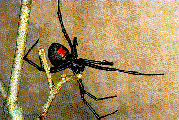 University of Florida -Entomology | The black widow spider is black with a red hourglass on the underside of the abdomen. |
The toxins will make people who are bitten very sick. Prompt medical treatment is recommended.
| The brown recluse is a light brown spider with a darker brown fiddle shape on its back. | 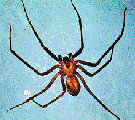 UK Dept. of Entomology |
The toxins cause tissue surrounding the bite to die and rot. For some people who are highly sensitive to the toxins, a bite can be a life-threatening situation. Seek medical attention promptly.
For more information, see
- Entfact 623, Eliminating Spiders Around Homes and Buildings,
- Entfact 631, Brown Recluse Spider, and
- Entfact 622, Common Spiders Found Around Homes and Buildings.
Original document: 7 July 1995
Last updated: 19 April 1999
 Return to UK Department of Entomology Katerpillars page
Return to UK Department of Entomology Katerpillars page Return to UK Department of Entomology homepage
Return to UK Department of Entomology homepage Return to University of Kentucky homepage
Return to University of Kentucky homepage